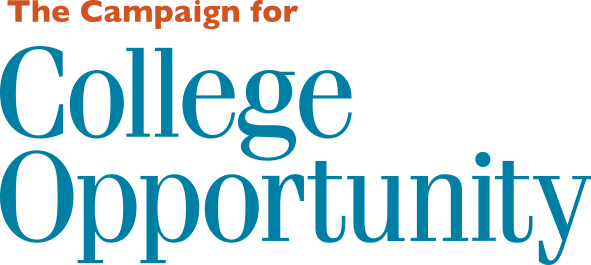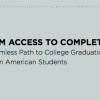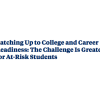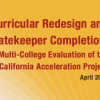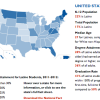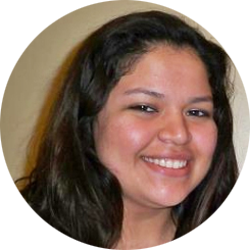
Yessica Escobar’s first semester at Los Angeles Community College (LACC) was challenging. She is like many hardworking California community college students who struggle to balance between work and achieving their academic goals. She is also a person who has exceeded all that her parents imagined possible for her.
For 20-year-old Yessica, college was not originally part of life’s plan. She is the second child of Maria and Jose, a sample maker in the garment industry and a building maintenance worker, respectively, both from El Salvador. “We just didn’t think college was a possibility. It seemed so expensive. We didn’t understand there was a difference between community colleges, UCs and Cal States. We just thought they were big money institutions that were too expensive for anyone as poor as us to get into,” Yessica recalls.
Yessica is bright and curious. She attended two Los Angeles public high schools, the James A. Foshay Learning Center and West Adams Preparatory High School, from which she graduated in 2009.
Mr. Cuevas, Yessica’s eleventh grade teacher, was especially influential. “He really got us into school. He told us we could be better than what the statistics might have said about us. He motivated most of our classmates to attend college. He inspired me a lot.” For the first time ever, Yessica’s mom attended a parent-teacher conference with Mr. Cuevas. “He told her that he saw in me the capacity to go to college. And after that I actually told my mom for the first time I’m going to college.”
In Yessica’s first semester, she enrolled in four courses at LACC, and she held two jobs: on Monday, Wednesday and Friday, she worked a full-time office job; during the week, she also worked a part-time night job babysitting four children under the age of five. Her days began at 5:30 a.m. and ended at 1:30 a.m. the next morning. On top of the arduous schedule, she had no car, so hours were added to her day commuting by city bus and subway. Because of this exhausting schedule, something had to give—and it did. Eventually, she dropped three of her four courses.
Yessica would have benefited from mandatory first semester orientation and counseling sessions.
“The first year was the hardest for me. My sister went to Cal State Northridge, so when I asked for help or advice, she didn’t have any because she wasn’t attending community college,”
Yessica said. She did not know what to expect, and shared, “it was the decision-making that was hard.” She did not know that completing a full course load of 15 units would not be humanly possible with her work schedule. She was uncertain which courses to take. Many conventions—like finals week schedule—were unfamiliar to her; she did not understand that finals have their own schedule and do not take place during regular class sessions. She did not know books could be purchased online at a greater discount than the college bookstore offered.
Along the way, Yessica also received bad advice from well-intentioned staff. When it became clear that she could no longer manage work and school, she consulted with a financial aid representative about the trouble she faced. The staff member advised her to withdraw from the classes. Yessica followed this advice, withdrawing from all but one class. Weeks later, she would learn there was a penalty for doing so—the college demanded repayment of the $900 student loan she had received and had used toward tuition and books. In the end, Yessica paid for four courses, but received credit for only one.
This unexpected debt created a financial hardship, but Yessica repaid the loan in two months’ time.
Beyond scheduling and financial aid challenges, Yessica would also come to find out that assessment tests could stifle her educational progress.
While California community colleges are designed for open access, most students must demonstrate their readiness for college-level work by passing assessment tests in language arts and math.1 The results of the test determine course level placement.
This unexpected debt created a financial hardship, but Yessica repaid the loan in two months’ time. Beyond scheduling and financial aid challenges, Yessica would also come to find out that assessment tests could stifle her educational progress. While California community colleges are designed for open access, most students must demonstrate their readiness for college-level work by passing assessment tests in language arts and math.1 The results of the test determine course level placement.
Math 125 is a non-transferable intermediate Algebra course, a math Yessica had already studied in high school. She had expected to place at least into Math 240, the next course in the math sequence and a college level, transferable course. “If I wanted to retake the test, I was told I had to wait six more months.” Rather than wait, Yessica took Math 125, passed it, and enrolled in Math 240 the following semester.
Since she could not retest immediately, Yessica took a course she did not need and she was denied the opportunity to advance her math skills and knowledge. This ultimately cost Yessica time and money. It also meant that a student who needed to take Math 125 could not.
Because transfer track students typically transfer to four-year institutions within four to six semesters, and because math courses are taken in an ascending sequence, a transfer track student will take no more than six math courses before transferring out of community college. Yessica laments that she will lose out on the option of taking an advanced math class—such as ordinary differential equations or linear algebra—because she had to take Math 125.
In her second semester Yessica visited a counselor, and he made a two-year transfer plan for her. The counselor advised her to take classes during the winter and summer intersession to make up for the units she lost the first semester. “I did it, and it’s now one of my favorite times to take classes.”
Yessica’s parents now see the importance of higher education. “Their mentality was get a high school degree, and then you can get a job. Now they see that we are in a better place,” Yessica said.
“Despite the challenges and difficulties with enrollment, I still know it is very important for people to go to college because it changes your life.”
Today, Yessica is on track to transfer in 2012, and she will double major in Math and History. Her dream school is the University of California, Los Angeles. She currently serves as a tutor at Bancroft Middle School, teaching math, English, history and science to 7th and 8th graders. Her younger brother is also now a freshman at LACC.
Student Success Indicator
Taking a “student success” course. Research shows that students taking courses that teach good study and life skills, along with helping them develop strategies for reaching their higher education goals and disseminating information about services and resources available to them, have better outcomes.* This classroom-based intervention can reach students like Yessica that may not otherwise seek help and can be more efficient than individual appointments with counselors that do not have the time to sit down with every student.**
SOURCES: *Florida Department of Education (November 2006).
Taking Student Life Skills Course Increases Academic Success. Tallahassee , FL.
**MDRC (February 2010). Can Improved Student Services Community College Student Success?
Washington, DC.
